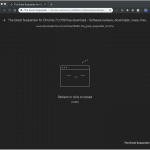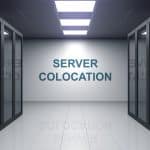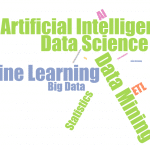Save resources by pausing open Chrome tabs using The Great Suspender

If you’re anything like us, you tend to remind yourself to follow-up a website by keeping a tab open. This often remains open indefinitely though, and over time, one tab quickly becomes many and you then move on by opening new browser windows.
But there’s a problem with this behavior. Have you noticed the system resources required to keen a browser tab open? Each tab can easily run at up to 150MB, as they contain images and dynamic content to host the web page. You only need ten open tabs and you’re allocating over 1GB of RAM to web pages to follow up at a later date. There must be a better alternative.
Keep installed software up-to-date using IObit Software Updater

Download software from the Microsoft Store and it will either auto-update or you’ll be notified when a new version is available.
Problem is, most of our software isn’t downloaded from one source, so we often have no idea when big new updates are available. It’s true some installed software will either auto-update or notify you from within the software itself. Examples include web browsers such as Chrome or Firefox, your security software and Windows.
5 tips to help CIOs overcome patching problems

With endpoint attacks on the rise, and the risk and cost of a data breach steadily increasing, protecting enterprise networks has become an urgent priority. And, it seems that no one is immune: in a recent survey of global companies, 93 percent experienced a cyberattack in the last year. For one-third of those companies, attacks were a weekly occurrence.
While cybercriminals are certainly working overtime to find new opportunities to wreak havoc, the truth is that CIOs and those in charge of enterprise security bear some of the responsibility for the increasing prevalence of attacks. Last year, nearly 60 percent of successful breaches exploited known vulnerabilities, and of those organizations that were victims of attack, nearly 40 percent admit they were aware of that vulnerability prior to the event.
10 best apps for people seeking jobs (or side hustles) in 2019

In addition to being amazing tools for communication, smartphones and tablets can play a dominant role in helping you find a job. Whether you are a recent college graduate seeking your first serious job or a 30-year professional looking to make a change leveraging the possibilities of the gig economy, harnessing the capabilities of your phone or tablet can significantly increase your odds of success.
Here are ten apps that can help you zero in on the right job, navigate the application process, and ace the interview.
Locate and remove hidden Windows 10 apps using O&O AppBuster

If you use a laptop with a small SSD, you'll want to make sure you can reclaim as much hard drive space as possible. Many of the default apps Microsoft installs with Windows 10 can take up more space than you might realise and, better still, most can be removed simply and easily.
Take the Skype app, as an example. This app is now installed by default as Microsoft is keen to encourage us to use their technology. Problem is, it takes up nearly 0.5GB of your SSD, for an app you may never consider using.
3 data leaks that could be undermining your online privacy

Protecting your online privacy is important. There has been a lot of discussion in recent years about how to stay safe online, and an increasing number of people are turning to Virtual Private Networks to keep their browsing data hidden from advertisers and overzealous intelligence agencies.
However, your privacy could still be at risk even behind the protection of a VPN. There are three common vulnerabilities that can leak information about you online: WebRTC and DNS leaks which affect VPN users, and app data leaks which can affect anyone and everyone. Read on to find out more about these three types of data leak, and what steps you can take to prevent them.
Software development isn't a manufacturing process

The following is an exclusive excerpt from Project to Product: How to Survive and Thrive in the Age of Digital Disruption with the Flow Framework by Dr. Mik Kersten:
Entering the BMW Group Leipzig plant in Germany is an awe-inspiring experience. My hosts are Rene Te-Strote and Frank Schäfer. Frank is a plant manager responsible for overall vehicle integration. The enormous Central Building was designed by architect Zaha Hadid, who designed some of the most unique buildings of our time. The unapologetically sci-fi architecture invokes the feeling of walking into the future. The most prominent sight upon entering is an elevated and exposed section of the production line that towers high above eye level. Car bodies move across a suspended conveyor and then slowly disappear out of view as they glide over a sea of desks. The production line is visible to anyone who enters the building and to all the staff, and the entire building is designed around it. Every part of the building has some practical aspect related to manufacturing and value delivery. Everything embodies the maturity and scale of one of the masters of the Age of Mass Production.
5 industries being revolutionized by 3D Printing

Ever since its conception, 3D printing has represented a significant leap forward in technology. Granted, many people believe there was an excessive amount of hype around 3D printing when the tech first hit markets.
While there were some kinks to work out, however, no one can deny the revolution that swept over almost every industry in the world. The simple idea of creating anything from nearly any material in the comfort of your home or warehouse has meant that suddenly, a lot of middlemen are getting cut out of a job. Yet, for the businesses themselves, 3D printing has been a game-changer and a massive boon to their revenue. The technology managed to affect a lot of industries very differently, but here are a few of them.
What's the role of colo in the era of Multicloud and Hybrid IT?

The year is 2010. Cloud adoption is growing by leaps and bounds. Soon, everything will be in the cloud, and why wouldn’t it be?
But here in 2019, we know now that the narrative has shifted a bit. Our recent survey, The State of IT Infrastructure Management, only proves that the story is a little more complex than 100 percent cloud: Among organizations moving some of their on-prem infrastructure off-prem within the next three years, nearly four in 10 plan to move to a colocation environment.
Three stages of risk-based vulnerability management: Crawl, Walk, Run

The market is saturated with hundreds of security products, and companies spend billions of dollars each year on cybersecurity spend (expected to top $100 billion by 2020). Yet breaches and hacks are still in the news every day, because cybersecurity is such a tough problem. Organizations have a massive and exponentially growing attack surface -- there are a myriad of ways by which networks can be breached. Analyzing and transforming the enterprise cybersecurity posture is not a human-scale problem anymore. An enterprise vulnerability management program is the cornerstone for any modern cybersecurity initiative and helps security teams proactively understand and improve their security posture to avoid breaches and protect the business from brand and reputation damage, as well as loss of customer trust.
Understanding and acting on data output from your vulnerability assessment scanner is a critical component of your vulnerability management program. However, if your scanner is identifying vulnerabilities by the thousands every time a scan completes, your team will soon be left overwhelmed and struggling with how to proceed. Failure to address vulnerabilities in a timely manner due to the high volume of alerts is very problematic. And of course, most of these vulnerabilities are bogus or merely theoretical. Traditional vulnerability management programs leave you drowning in data, but starving for insights.
Could 'Do Not Disturb' be the key to employees’ digital wellbeing and CSR?

Employee happiness; it’s a pretty important thing these days. It isn’t just a fluffy, nice-to-have feeling for employees. It’s a business necessity.
Without it, employees don’t feel a strong connection to their employer’s mission and values. And when that happens, it means employees are disillusioned, don’t feel supported and recognised for good work, and are less likely to stick it out long-term with their employers. That’s what I call a recipe for turnover disaster. But in reverse, when employees feel strong mentally and feel like they enjoy working for their employer, it improves morale.
Failover clustering in the Azure cloud: Understanding the options

A number of options are available for providing high availability protection for applications running in the Azure cloud. Some of these options are cloud-based services. Some are in the operating system or application software. And some are purpose-built by third-parties. The numerous permutations and combinations available can make it extraordinarily difficult to choose the best and most cost-effective solution for each application.
In general, failover clusters are the best option for assuring high availability. Historically, failover clusters were relatively easy to configure and test in the enterprise datacenter using shared storage and standard features built into Windows Server. But in the Azure and other public clouds, there is no shared storage. This creates a need to find other options for running mission-critical applications in a public or hybrid cloud environment. This article examines the options available for providing high availability (HA) for applications running within the Azure cloud. Special emphasis is given to SQL Server as a particularly popular application for Azure.
What's in a name? Artificial Intelligence or Data Science?

If you are like me, there is a good chance that you are confused as well about the most recent terminology to use in the field of data science … pardon, artificial intelligence … no, I mean data science. No, I mean artificial intelligence. Please, somebody tell me what I should call it and what the difference is!
Isn’t artificial intelligence just a new cool name to label the old traditional data science? Don't both concepts cover the same algorithms? And isn’t it all machine learning anyway? This is what I used to think until I took a pause to write this post. During this breather, I went back in time and tried to remember all the names that used to be used to label this field of what essentially is data analytics. Let’s see …
Trust, transparency, and the rise of explainable AI

Most organizations are currently in the process of investigating, planning, or deploying artificial intelligence (AI) implementations, but there’s a problem: businesses -- or even AI designers -- don’t understand how or why the AI arrived at a specific decision. This is a big hurdle for businesses who want to begin relying on AI-based dynamic systems for their decision making. In fact, a recent PwC survey found that 37 percent of executives said ensuring AI systems were trustworthy was their top priority, and 61 percent would like to create transparent, explainable, and provable AI models.
The need for transparent, explainable AI goes beyond individual business preferences. Interpretability, fairness, and transparency of data-driven decision support systems based on AI and machine learning are serious regulatory mandates in banking, insurance, healthcare, and other industries. In addition, regulations like GDPR’s right to explanation clause or the upcoming California Consumer Privacy Act will compel businesses to know what their AI algorithms are thinking. The solutions to these issues of trust and explainability typically have been to stick with simpler models, improving transparency at the expense of accuracy. From my perspective, understanding how to create trust -- more so than creating transparency -- in AI is going to be crucial to success.
Bill Belichick installed an Event-Driven Architecture, so should you

Widely regarded as the greatest football coach of all time (much to the chagrin of NFL fans outside of New England), Bill Belichick has now 'enjoyed' six Super Bowls as coach of the Pats (plus two more as Defensive Coordinator for the Giants) and led the Pats to three-fourths of AFC Championship games (including a record-setting 8 consecutive trips).
But what’s really made Belichick great is his belief that you shouldn’t just "run what we run," but that you should game-plan specifically for each opponent. This means the strategies and actions they employ are based on what they expect each specific opponent to do. And if things aren’t working as planned, they switch it up and adapt (Belichick is the master of in-game adjustments). Here’s a few examples:
BetaNews, your source for breaking tech news, reviews, and in-depth reporting since 1998.
© 1998-2025 BetaNews, Inc. All Rights Reserved. About Us - Privacy Policy - Cookie Policy - Sitemap.
